How to Caramelize Sugar
The process of how to caramelize sugar is quite a simple one and is the start of many dessert sauces and candies. The technique may seem daunting at first, but once you get the hang of it it will open the door to many new recipes to master!
The process of caramelizing sugar feels like pure magic. Snowy white sugar granules are heated either solo or mixed with water and those crystals quickly become a liquid that starts to completely change in color and flavor. Caramelized sugar resembles nothing of its original state and the final result opens the doors to endless uses.
Caramelized sugar is used in everything from caramel sauces, candies, topping flan, ice creams, frostings, and so many more things! It’s even used for savory preparations such as the sweet and sour gastrique sauce.
The process for how to caramelize sugar can seem daunting, but I promise you it really isn’t. There is all kind of chemistry and science happening during the process, but I’m going to break it down for you and keep it really simple so you can approach this process with confidence!
What is Sugar?
The white granulated sugar most common in baking is a molecule known as sucrose. Sucrose is contained in all plants and is found in very high quantities in sugar cane and sugar beets. Therefore, these are the plants where most of our granulated sugar is derived from.
Sucrose is actually made up of two different kinds of simple sugars, fructose and glucose, that are bonded together. This bond is very stable and is what forms the sugar crystals.
The Stages of Sugar Syrup
When sugar is combined with water and heat is applied a solution known as a simple syrup is formed. As the temperature of the sugar rises, more water evaporates off resulting in a higher concentration of sugar in the solution. The higher the concentration of sugar, the more brittle the cooled syrup is. This is important knowledge in candy making, as certain sugar concentrations are needed for various final products.
Below is a chart mapping out the various stages sugar syrup goes through before it reaches caramelization.
| SUGAR SYRUP STAGES | TEMPERATURE FAHRENHEIT | TEMPERATURE CELSIUS | USES |
| The Thread Stage | 215-230°F | 102-113°C | Syrups, Preserves |
| The Soft Ball Stage | 240°F | 115°C | Fondant, Fudge |
| The Firm Ball Stage | 245°F | 118°C | Caramel Candies |
| The Hard Ball Stage | 250-260°F | 122-127°C | Marshmallows, Nougat |
| The Soft Crack Stage | 270-290°F | 132-143°C | Taffy |
| The Hard Crack | 300-310°F | 149-154°C | Butterscotch, Brittle |
Caramelizing Sugar
When high heat is applied to sugar it begins to discompose and become a liquid. When sugar is heated even further it begins to turn darker in color and tastes nuttier in flavor. This process is called caramelization and is the basic process used to start many candy recipes and dessert sauces.
There are two basic methods used for caramelizing sugar: The Dry Method and The Wet Method. If done properly, both methods achieve the same end result, but both have their advantages and disadvantages. It really is a matter of preference.
The Wet Method
The wet method is what I recommend for those who are brand new to the caramel making process. The benefit of the wet method is that it slows down the caramelization process and makes it more difficult to burn the sugar. The disadvantage of the wet method is that you are more at risk of re-crystallizing the sugar and you must be much more careful to not agitate the mixture too much.
The process of making wet caramelized sugar is very simple. Sugar is combined with water and heated. The mixture should be stirred together until the sugar is completely saturated and beginning to dissolve. Once the sugar/water mixture comes to a boil it is then left alone to cook, without stirring it. The mixture will go through all of the sugar syrup stages listed above and then will move further into caramelization. As the water continues to evaporate off and the heat of the sugar rises, the sugar begins to caramelize.
The Dry Method for Caramelizing Sugar
The dry method for making caramelized sugar is also very simple, but has its advantages and disadvantages. The major advantage to the dry method is that the caramelization process happens very quickly. The major disadvantage to the dry method is, well, the caramelization process happens very quickly, meaning it can also burn quickly. The other advantage of the dry method is that it is not quite as at risk for re-crystallizing as it is with the wet method.
The process of making dry caramelized sugar requires just one ingredient: sugar! In a heavy bottom sauce pan, sprinkle a thin layer of sugar over the bottom and turn on medium heat. You do not want to dump all of your sugar in at once, just start with a thin layer. As the sugar starts to melt, sprinkle more sugar over the layer that is melting. Using a spoon or a spatula, gently drag the un-melted sugar into the melted sugar. You are at less risk of re-crystallizing the sugar with this method but you still do not want to stir aggressively.
The Stages of Caramelized Sugar
Once most all of the water is evaporated off (even if you use the dry method sugar does contain some water that will evaporate off), the sugar moves into the caramelization stages. A candy thermometer can be used to measure the exact temperature of the caramelized sugar, but your eyes and nose are your best tools to judge when it is ready. Stay close by and watch the process of your sugar caramelizing very closely. Once it starts to brown it can move from nutty and rich to black and bitter very quickly.
Baking Science Fact: Granulated sugar is a very simple bond of glucose and fructose. As heat is applied to the sugar this bond breaks and the two molecules separate out. As even more heat is applied, these molecules begin forming bonds with countless other molecules and the ending result is the complex flavored brown liquid known as caramelized sugar.
| CARAMEL STAGES | TEMPERATURE FAHRENHEIT | TEMPERATURE CELSIUS | USES |
| Light Caramel | 340°F | 170°C | For Syrups, Light Caramel Color, Adds Flavor |
| Medium Caramel | 355-360°F | 180-182°C | Spun Sugar, Sugar Cages, Medium Caramel Syrup |
| Dark Caramel | 375-380°F | 188-190°C | Ice Creams, Caramel Sauce |
| Black Caramel | 392°F | 200°C | Caramel coloring |
| Burnt Caramel | Anything over 392°F | Anything over 200°C | Completely burnt and unusable for anything |
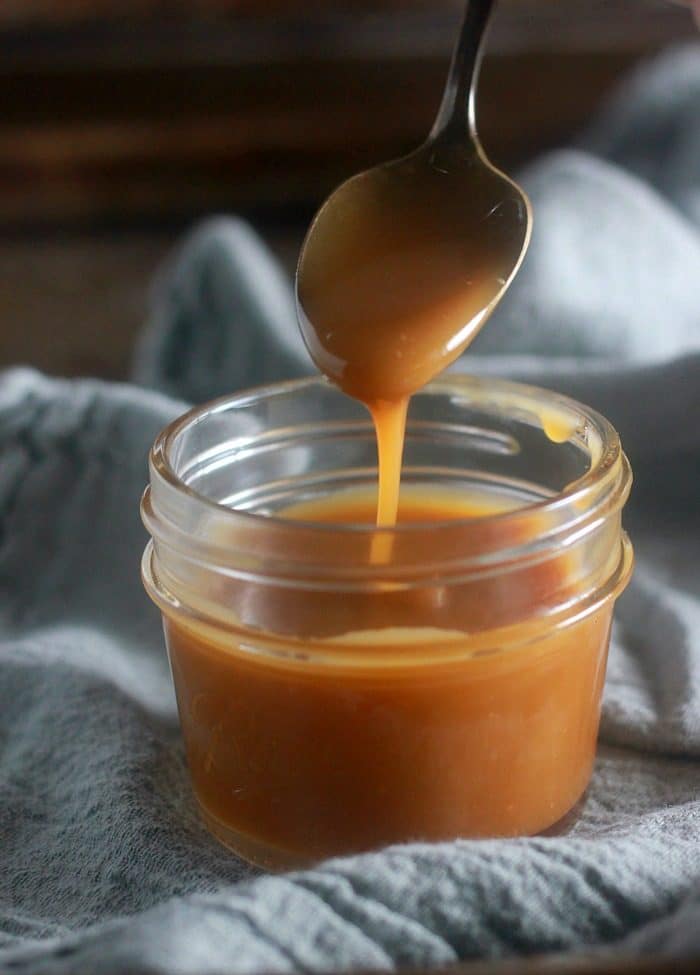
Caramel Sauce made with medium/dark caramelized sugar
Safety Tips
When cooking sugar you are working with very high temperatures and a substance that is very sticky and can easily cling to skin. Please use caution. I’m not here to scare you into not trying to work with sugar, because honestly it is not a scary process! But I do want to urge you to use caution. As someone who tends to lick the spoon when cooking, I urge you to use restraint during the cooked sugar process!
Here are a few easy safety tips to put your mind at ease when working with cooked sugar:
- Keep a large bowl of ice water nearby. If by some chance you happen to get sugar splattered on your hand, you can quickly dunk it in the ice water.
- Use a larger pan than you think you need. When I am making a small batch of caramel sauce (about 1 cup), I use a sauce pan that is 3 quarts. You definitely do not want to use small pans when working with bubbling sugar.
- Use a spoon or spatula with a long handle. You do not want to use anything with a short handle here, especially if you are going to be adding cream or another liquid to your caramelized sugar. The addition of a cooler liquid to your boiling sugar will cause an increased amount of bubbling and steam once it is added to the pan.
- Stay close-by and mentally present. When working with molten hot sugar it is best not to wander away or be distracted by your phone. The process can happen quickly so continue to be mentally present so you can be aware of what is happening and do not feel frantic when the sugar begins caramelizing.
Required Equipment
The process of cooking sugar is quite simple and depending on what you are making exactly, you may or may not need certain equipment. Below is a list of equipment you definitely need when cooking sugar for any use as well as additional equipment you may need depending on what the sugar will be used for.
Heavy Gauge Metal Pot, Required: Required for any of the cooked sugar uses. The heavier the pot, the more evenly the sugar will cook. If you are making something that requires adding liquid into caramelized sugar, such as caramel sauce, than you need it to be much larger than the amount you are making because it will bubble quite a bit once the liquid is added. Non-stick or coated pans are not recommended for cooking sugar as the sugar can pull the coating off the pan.
Candy Thermometer, Highly Recommended: If you are cooking sugar syrup for candies, a candy thermometer is extremely useful for accurate temperature. Various kinds of candies call for the syrup to be at different stages and the thermometer is setting you up for success. If you are simply making caramel sauce, you can get away without using a thermometer. You can rely on your eyes and nose as well as approximate timing to get it right. However, certain caramel creations such as soft caramel candy as well as caramel to coat apples require more accuracy with the final temperature.
Long Handled Spoon or Spatula, Highly Recommended: A spoon or spatula with a long handle is highly recommended, especially if you are going to be stirring liquid into your caramelized sugar to make caramel sauce. If you do not have a utensil with a long handle, consider wearing long sleeves and an oven mitt or gloves while working with the sugar to be extra safe.
Pastry Brush, Optional: Many cooked sugar recipes swear by the fact that you MUST brush down the side of the pan with a pastry brush. I would argue that I have never once done this with any of the caramelization endeavors and have not had any problems. Instead, simply take care to keep the sugar in the bottom of the pan. If you are using the wet method of caramelizing your sugar than know that you CAN stir it before the sugar is dissolved. Do not be scared to do that. Many recipes harp that you can not ever stir it and this is simply not true. Make sure all of the crystals are off of the side of the pan and dissolving in the water. This eliminates the need for the pastry brush.
Now that you understand all the basics of caramelizing sugar, come back Thursday for my tutorial on making Caramel Sauce for dipping and coating apples! Caramelizing sugar leads to really wonderful things!

How to Caramelize Sugar
Caramelized sugar can be achieved through two different methods: The Dry Method & The Wet Method. This "recipe" details each method for How to Make Caramelized Sugar to use in any recipe calling for it.
Ingredients
- 200 grams (1 cup) granulated sugar
- 120 grams (1/2 cup, 120 milliliters) water
Instructions
- For the Wet Caramelized Sugar MethodIn a heavy gauge metal pot, at least 3 quarts in size, combine the sugar and the water and stir. Make sure there are no sugar granules on the side of the pot. If desired, you can use a damp pastry brush to brush down the sides of the pot to get all of the sugar crystals into the mixture.
- Turn the burner on to medium heat. Stir some at the beginning to make sure that all of the sugar is dissolving. Once the sugar is dissolved and the mixture is beginning to bubble, stop stirring.
- Let the sugar and water cook together. The syrup will move through the various sugar stages as the water evaporates and will eventually begin to caramelize. You can gently swirl the pan to achieve even caramelization.
- Watch the pan closely as the process moves quickly. Remove the pan from the heat as soon as your caramelized sugar has reached its desired color.
- For the Dry MethodIn a heavy gauge metal pot, at least 3 quarts in size, sprinkle a thin layer of sugar over the bottom of the pan.
- Turn the burner on to medium heat. Watching very closely, allow the sugar begin to melt. As it becomes liquid, sprinkle more granulated sugar over the melting sugar until it has all been added.
- Use a rubber spatula to gently drag the granules of sugar into the liquid sugar. Do not aggressively stir but gently move the sugar around to achieve even cooking.
- The sugar will begin to caramelize very quickly once it melts. You can turn the heat down to slow the process down.
- Remove the pan from the heat as soon as your caramelized sugar has reached its desired color.
Use your caramelized sugar in your desired recipe. Pure caramelized sugar, like this, will harden very quickly so work quickly to use it in your recipe.
Notes
Your eyes and your nose are your best tools for measuring when your caramelized sugar has reached its desired color. However, you can use a candy thermometer for more accuracy.
- Light Caramel (For Syrups, Light Caramel Color): 340°F/170°C
- Medium Caramel (For Spun Sugar, Sugar Cages, Medium Caramel Syrup): 355-360°F/180-182°C
- Dark Caramel (For Ice Creams, Caramel Sauce, Caramel Candies): 375-380°F/188-190°C
- Black Caramel (Used as Caramel Coloring): 392°F/200°C
- Burnt Caramel (Not usable, throw out and start over): Anything over 392°F/200°C
Advantages of The Wet Method: Easier to control the caramelization process, less chance of burning. Disadvantages of The Wet Method: Takes longer to caramelize, more risk of re-crystallization Advantages of The Dry Method: Very quick process, less risk of re-crystallization Disadvantages of The Dry Method: More difficult to control, more risk of burning
Recommended Products
As an Amazon Associate and member of other affiliate programs, I earn from qualifying purchases.



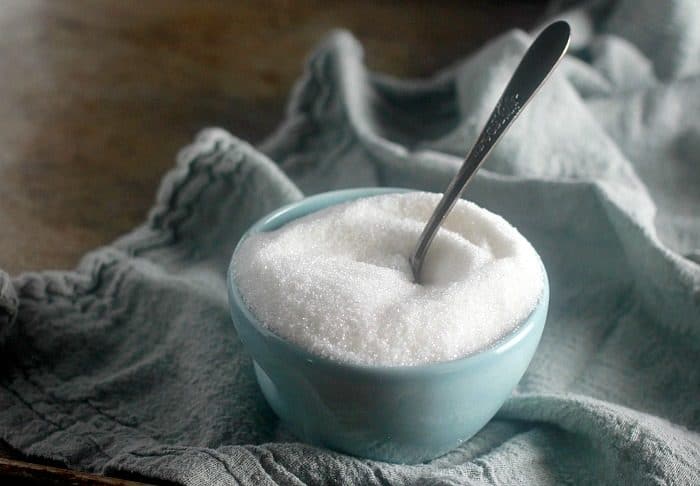
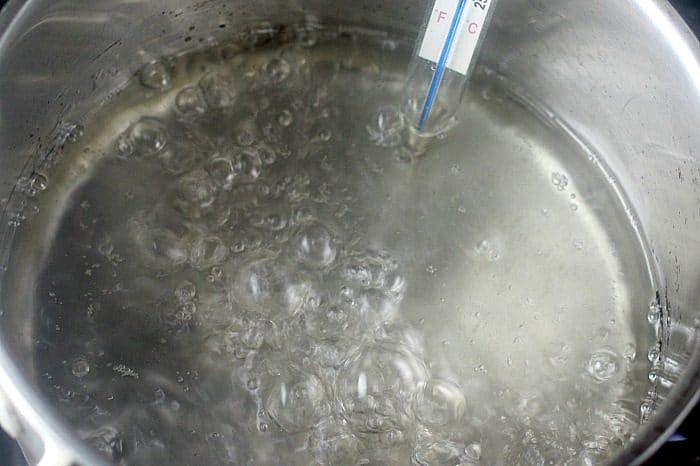
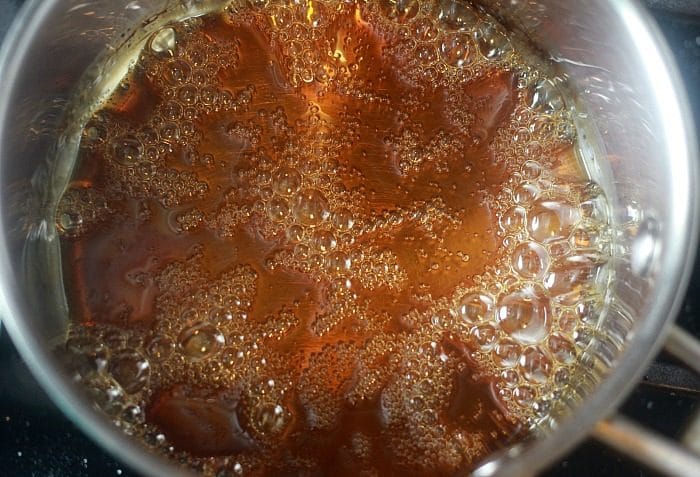
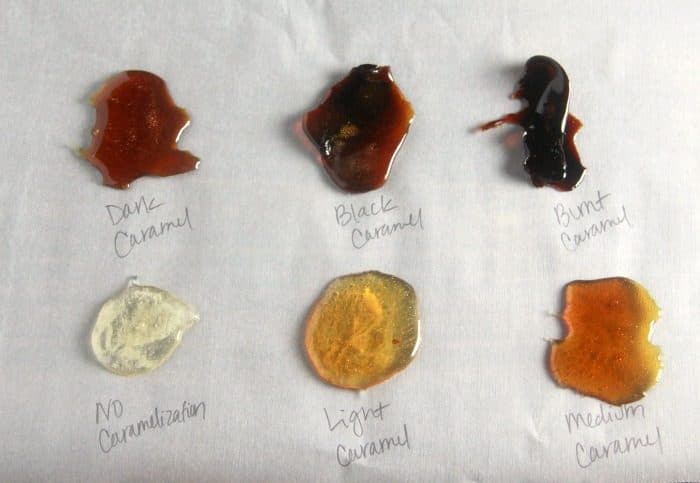
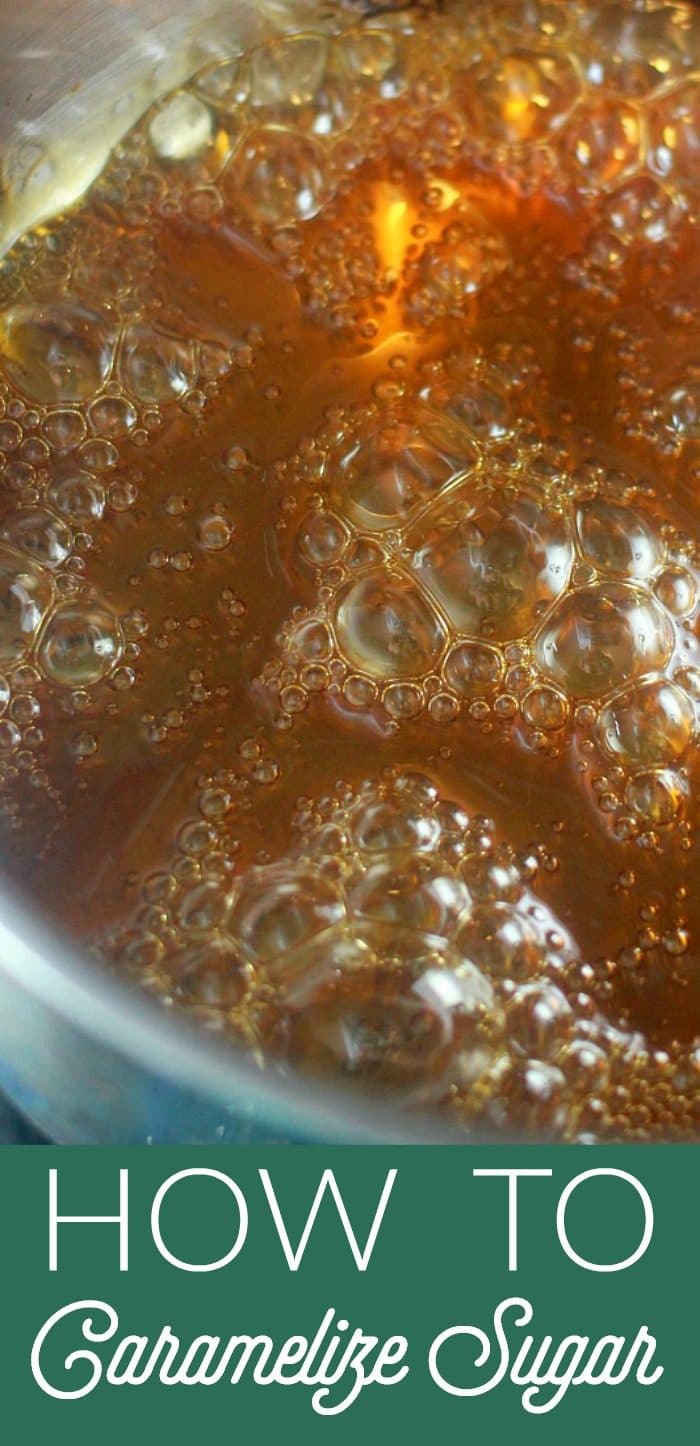



69 Comments on “How to Caramelize Sugar”
As always, the only time I care about science is your posts! Love caramel <3 (I usually use the dry method lol)
Ha, I’m with ya, girl!
Comparing the two methods, is the taste the same? Like if I did each one to a medium caramel, would they taste the same? Or does the dry caramelization taste better since it is only sugar and no water?
Also with the dry method as each layer melts do you keep adding sugar until you get your desired amount? I needed 2 cups of caramel
Hi there! Great question! The resulting caramel from the two methods is exactly the same as the water evaporates off of the wet method. The benefit of the wet method is that it is a slower process and therefore easier to control it not burning. Some people do prefer to keep adding layer upon layer when doing the dry method, but I find that this is not necessary as long as you are paying close attention. It will all even out.
I used the dry caramel for my creme brulee doughnuts it was perfect yesterday it looks really nice on top of my doughnuts, i stored it on fridge as i check on it today it melt down =( do you have a proper storing for it? Thank you so much
Caramel tends to lose its hardness when exposed to moisture like in the fridge. Donuts specifically are best when eaten fresh so I suggest only storing in an airtight container on the counter for a day.
Thank you for explaining it so beautifully!!
You’re welcome Manu! Hope it is helpful!
I caramelized the sugar but when i transfer into another bowl it got stuck, so wasn’t able to swirl around the bowl. Why do you think that happened.
Hi Puja, what were you trying to make with the caramelized sugar? Caramelizing sugar is a technique that you use to be paired with other things or to make hard caramel sugar decorations or “spun sugar”. Once sugar is caramelized it will harden quickly when it cools. Were you wanting to make a caramel sauce? If so, you will need to add cream and butter. You can find the caramel sauce recipe here: https://bakerbettie.com/make-caramel-sauce-video/ Hope that ehlps!
I eyeballed measurements for the sugar and water. I had it on medium-high heat. When I transferred it to my aluminum pan, it continued cooking, and ended up burning. Could it have been I had too much water or I had the stove too hot? What went wrong?
Hi Rose, You can caramelize sugar with any quantity of water or none at all. The sugar will not start caramelizing until all of the water is evaporated out. The water just ensures the process won’t go too quickly. Did you transfer it from one hot pan to another? I’m not following the part where you said you transferred it to your aluminum pan. Likely it burned because the pan was too hot.
I also need to transfer to another pan. It’s the method to make any kind of flan.
You make the caramel (dark) on a pot on the stove and when it’s
almost done you transfer to your baking pan to cover the bottom and part of the sides. It is kind of tricky . The only reason I think why Rose’s burned has to do with the caramel being transferred when at a darker stage and since it will keep on cooking until it becomes solid in the baking pan, it must have gone above that perfect temperature.
After you have your flan pan “lined” with the now hardened caramel it is ready to fill with your flan mixture and put in the oven to cook.
When it is done, you cool it and turn over on a serving dish that is not completely flat.
The flan will have a darker top (the caramel mixed into the top layer), and will be surrounded by delicious liquid caramel sauce.
I think I got tempted and will make one tomorrow. (I make it with eggs, sugar and almond milk to keep it lactose free.)
Thank you so much for your tips on how to make and handle the caramel. It’s so worth making. I have not ever found this quality of flan in any restaurant.
I have actually never made flan! That sounds delicious. I hope it turns out well!
Bettie, your instructions to making caramel are so wonderful. I think with them anybody interested can easily make flan. It’s the only part that is a bit intimidating for people not familiar with making and using caramel.
It’s just a matter of being fast when turning the pan around to cover with the caramel that can be tricky. You want a thin layer covering the whole inside of the pan.
I’m looking for a new pan for it. I always made it in a flute pan, more like a bundt Kugelhopf pan that was a basic tin pan. The caramel sticks easily and it looks beautiful when you turn it out when cool. Seems like most cake pans today have some kind of nonstick surface. And you don’t want that. The caramel that sticks well to your pan will be the best nonstick surface for your magnificent flan. I would love your pictures and comments when you make it.
By the way, the best flan recipe is using sweetened condense milk diluted with water, eggs and vanilla for extra flavor. Simple. Enjoy!!
Sounds wonderful Monica! I’m so glad you enjoyed this tutorial!
So in carmelizibg pecans, and following the rules of all the recipes I’ve tried, the sugar always crystallizes on the nuts instead of achieving the caramel color. Is th temperature too low?
Hi Debbie! Are you doing them in a pan or in the oven?
Thank you for this page! I’m not much of a cook on a good day, but somehow I got suckered into making flan for my son’s “Foods of Mexico” segment in social studies. I was completely clueless. I followed the recipe the first time, disaster. Found this and viola – perfection!
What a great parent you are! So glad you found this helpful!
How do you meld in butter with caramelized sugar ?
Thanks for the pastry brush comment
I have always been told not to stir and to brush down sides of pot
You’re welcome!
This came out awful, my caramel burnt and stuck to my bowl and thermometer, do NOT try this.
um, you do know that caramel is basically sugar and you can easily clean it off by just dunking it in water… This is actually a really good tool for making caramelized sugar but I think all the recipes for making caramelized are almost the same. i dont think its the recipes fault either way, you probably just cranked the heat up too high or put it for too long.
I have in thr past made lovely caramel with the dry method, but any attempt with the wet method has crystallized. Lately I can’t seem to succeed with the dry, either. No matter how I do it, some of it burns before it’s all melted, and I come up with a bitter mess. I wonder if it’s because where I live now I can only get beet sugar? I sure would like to figure it out!
Hey, do you have any tricks on how to keep hard candy crunchy and not sticky after a couple of hours?
Big question! I am trying to make salted caramel hot cocoa mix. Caramel comes out great until I try to make it a powder. Then it even locks up the food processor. How do I prevent this? How should it be stored? TIA
Hi Cindy, I have never tried turning caramel into a powder but I looked up some articles. And they say to pour the hot caramel onto a sheet tray while it cools. Then put the hardened caramel into your food processor. Make sure your processor is very very dry as any moisture will make it clump. I would store it in an airtight container. I’m unsure how long it is good for though. Sorry I’m not much help!
Wait so all in all it’s 2 cups of sugar, as stated in the ingredient list?
Beautifully stated.
Thank you!
I want to make “Beer Nuts” What Temperature,and which melting process, would you recommend?
I learnt a lot thank you
You’re welcome!
I tried the wet method and ended up with something that looked like wet sand. What did I do wrong?
I admit I used it anyway in a peach upside down cake. The cake was delicious but I’d really like to improve my caramel making ability.
I suspect that the sugar didn’t have enough time to dissolve. It’s important that all of it melts before it starts to caramelize. Keep the temperature pretty low until it’s fully melted. Then you can tun up the heat just a smidge for it to caramelize.
Does it matter if I use an electric stove or gas?
It does not!
I am wondering if I could use cane sugar or must I use granulated white sugar?
Yes, you can
I recall making a clear caramel sauce for a Christmas pudding years ago and now I can’t find the recipe. I made it with caramelized sugar (the dry kind). Would I have added water instead of cream once the sugar was caramelized?
First, I tried the dry method, but the sugar crystallized into crumbs. Not liquid. And the color didn’t turn to golden.
Then I tried the wet method. The dissolved sugar remained transparent in color. Not golden color. What went wrong?
The dry method is so hard to get right. The sugar has to be very evenly heated for it to all melt at the same time. Once it’s all fully melted, keep going and it’ll darken. I find the wet method a little more manageable. Keep it on the heat on low until it is all melted including the little chunks, go very slow. Once it’s all melted, you can turn it up a tiny bit so it will darken.
I want to make flan for Christmas and I had trouble making the melting sugar. Could you please help? Thank you!
Go really slow on your stove and turn the temperature to low. Keep moving the sugar around so it stays even in the pot. Make sure not to get any granules on the sides of the pan.
very nicely explained God Bless you
You have not mentioned how to coat another pan or small cups for dessert . At what stage
Hi, I’m not sure what you mean. What are you looking for?
I made the wet method, and the process went smoothly, everything melted and slowly started to darken, as I stirred consistently. I stopped at a light/medium brown color and my thermometer never went over 330. When the sugar cooled I noticed a mild note of burnt sugar taste, not overwhelming, but not what I had expected. Did I somehow scorch some of the sugar even though I was stirring and the sugar never got close to a dark color or is that note of burnt sugar normal?
I want to caramelize pecans and walnuts. I tried the dry method (that I use with flan), but the nuts clump together too much and get too much or the sugar on each nut. I want a thin coat of caramelized sugar on the nuts. Can I make the caramelized sugar (dry method) and add water to make a slurry that I can evenly coat on the nuts, then dry in the oven? Open to any method/suggestion.
Hi! Try my recipe located in my post called “How to Candy Nuts”.
Which type of caramel(from the above list) is used for fruit cakes or christimas cake.
Is it dark caramel or black or burnt caramel.
Good intro explanation to very fundamental baking task.
Nick
I was making a Bon Appetit recipe for Caramelized Vietnamese-Style Pork Chops. The instructions were sparse for making the caramel and it was my first time, so I found your instructions. I used the wet method and overall I think your instructions are good and easy to follow. But step #4 could use a little edit. I had a feeling the caramel would continue to cook some after removing it from the burner so I took it off a bit lighter than I was going for even though the instructions say to “Remove the pan from the heat as soon as your caramelized sugar has reached its desired color.” Unfortunately, mine continued to get much darker after I removed it from the heat and it ended up bitter. If I’d known it would continue to cook so much off the burner, I would taken it off at a much lighter stage even though I was going for a dark caramel. Otherwise, everything else made sense. Thanks for this information!
liquid sugar for iced tea
Oops. My question is I want to liquify some sugar to use in ice tea or other cold drinks. regular dry sugar does not always dissolve, right?
So, if I use the “wet” method above and get the sugar\water mixture to turn into a clear liquid (over heat), am I done? Can I keep some or all of it in a container? Thanks 🙂
For what you are looking for you’ll want to make what’s called a “simple syrup”. You’ll put water and granulated sugar in a pot. Boil it until the sugar completely dissolves and you can see no granules. Then you’ll stop cooking. You can look up a recipe for simple syrups to give you the correct ratio of water and sugar.
What is sugar? Just tell me how to freaking make it I’m standing at the stove now! Holy
Do you have any tips for caramelizing sugar in butter for almond roca? The first problem is the butter separating after the inital blending of melted butter and sugar but before the sugar is completely caramelized. I have a suspicion that temperature is the answer. I’ve never heard not to stir it once the sugar begins to melt! I’ve been taught to stir constantly to prevent the sugar from burning, again leading me to think temperature is the key.
An Aunt many years ago used dry method and made a pie. Have searched for this recipe. Had a flavor not found anywhere else.
I am trying to perfect flan. Do u teach this?
When using the wet method, does the sugar needs to be dissolved first before heating it up?
No, just combine and follow the instructions.
I have a question regarding making a lace oatmeal cookie for the holidays. (Referring to the recipe’s instruction) I’d like to use coconut sugar instead of white/cane sugar to melt in butter, to create what should look like a caramel before adding the other ingredients to create the ‘dough’. Will coconut sugar work in the same capacity as white/cane sugar? If so, any tips for me? I’ve tried it once but the coconut sugar seemed to separate into a sediment rather than thickening up and creating a buttery caramel.
Please don’t give health advice if you don’t know what you are taking about
Unless it’s been edited, I’m not really sure if there was any health advice there.
The advice not to lick a hot spoon, and keep a bowl of ice water handy in case of molten sugar splashes, are safety measures. Wise ones at that.
Begs the question, do you know what you’re talking about?
Other than that, Bettie,
A nice piece. I had always thought I could make caramel doing this, and just this. Now I see it’s like making a Hollandaise, a base, and I want to get to Bearnaise (caramel). So I now know I will start here, then go to the butter/cream stage to get to caramel.
Are there any limits to flavourings for caramel? Like they way chocolate and bubblegum don’t work, ruining the structure/texture?
Why do you need two separate lots of sugar with the wet method?
Hi, my apologies! I just edited it. It’s now correct.